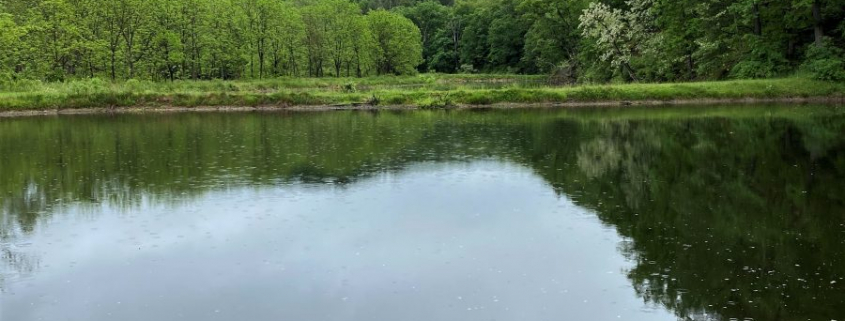Evitts Creek Three Ponds
I admit to a decades-long Nature-love-affair with West Virginia’s Dolly Sods Wilderness and Wyoming’s Teton Mountains, among other sweet spots. Although not rising to love-affair status, my relationship to a handful of other places rates as lifelong friendships. I recall fishing with Dad at Evitts Creek Ponds at pre-school age some 65 years ago. I revisited the ponds May 24, 2021, stirring a few vivid memories and forcing me to discern changes from long ago. Spring 1970 my Systematic Botany lab traveled several times to the ponds in search of spring ephemerals as the season progressed from winter dormancy to a succession of species flowering before the mid-May semester close.
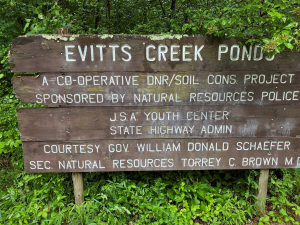
My History with the Three Ponds
I left western Maryland to complete undergraduate studies out of state in late summer 1971, returning occasionally over the years to visit family and friends. When visits overlapped with spring wildflower season I would visit the three ponds. I believe that my May 2021 hike followed a two decade absence from the property. Once I entered the higher education senior administrative ranks (president at four different universities), I drifted professionally from my natural resources roots. Retirement has blessedly returned me to my passion-zone for Nature-Inspired Life and Living, releasing me from the distraction of business back at the respective university. I am now free of that burden. I can savor and relish total immersion in whatever natural area I visit, hence my celebration at returning to the three ponds, even with persistent rain that morning.
I’ll guide you across the diverse sites and soils I traversed to illustrate why professor Glenn O. Workman (Doc) brought his students here. We’ll begin with the location, oriented NE to SW along the left bank of Evitts Creek (Google Map aerial view): https://www.google.com/maps/@39.662306,-78.717083,663m/data=!3m1!1e3?hl=en-US
I’ve been unable to ferret the story explaining what prompted this DNR/Soil Conservation Project prior to the days of my youth. The mowed berm of the ponds (below left; view from the first pond to the SW) strikes me as little changed from my earliest fishing visits. I recall fishing along the hillside shoreline (below right), which I remember having far less forest and brush cover.

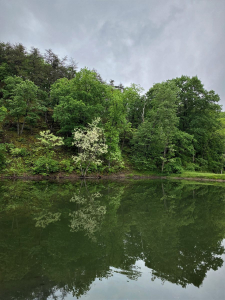
Below left is the view to the NE from the second pond. I do not remember the creekside border of trees (center left of that view). The 18-inch-long snapping turtle (below right) cruised along the surface of the third pond. I did not capture a clear image of the several hefty largemouth bass I saw as I hiked past the ponds.

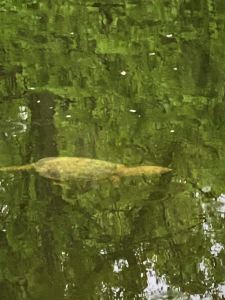
The fields and pond margins provided conditions for early spring meadow habitat flowers, all distinct from what Doc knew we would find blooming within the forests.
The Forest
A small stream (likely seasonal) entered the southwest corner of the third pond. This leaning sycamore stands just 40 feet from its channel on rich alluvial soil. The sylvan hollow adjacent to the drainage area, with high overhead canopy and deep shade likewise harbored its own set of spring ephemerals for our course lab visits, to include trilliums, trout lily, bluebells, and other species common to moist, rich, and sheltered sites. Speaking of shelter, I made it on my exit from the woods to the tree’s protective overhanging trunk (below right) just as a heavy shower arrived. I enjoyed the rain-show there for 10-15 minutes.
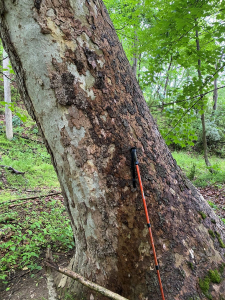
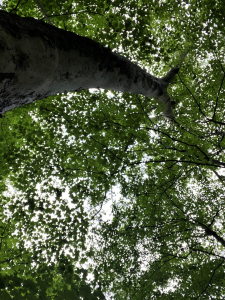
A 24-inch diameter white oak with its mossy trunk stood in a draw (see the leafy debris to its left from a recent freshet) entering the small stream from the east. The perspective below right of the same tree illustrates the slope lifting away convexly (from right to left) to the north. The slope therefore faces to the south (a south aspect), a hotter and drier slope position, less favorable to tree growth, particularly on the shaley soils here in Allegany County.

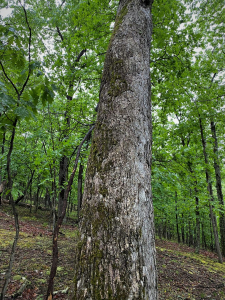
I followed the slope to the ridge top running east/west south of the ponds. I came across a hickory tree (below left) eager to point the way to a destination undisclosed to us human travelers. An Indian Marker Tree — no. Perhaps it is a tree-spirit marker tree? I like that mystical (and mythical) suggestion. Nearby, the chestnut oak (below right), just 10-12 inches in diameter, has the most deeply furrowed bark I have ever seen. Like some small dogs I have met, this tree’s bark stands out from its peers! These two trees are certainly unique…but why? Why is a hickory pointing to the right on my Blog Post page? Why does this chestnut oak have such a deeply furrowed brow? I can only surmise. Rather than I surmising for you, I suggest that you put your own imagination to work. I say often that every parcel of land…every tree…has a story to tell. What is your story for these two forest denizens?
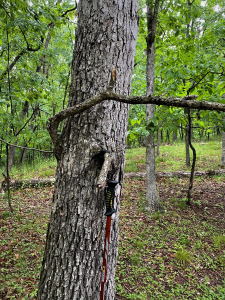
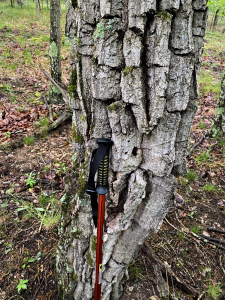
Traipsing up the convex south-facing slope, I saw clear evidence of its xeric nature. Stocking (the density of trees per acres) declined; heights shortened; species composition shifted to predominantly white and chestnut oaks; mosses and lichens increasingly covered the forest floor.
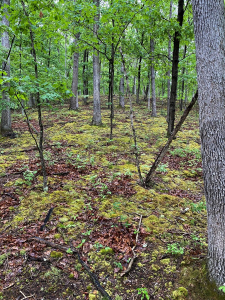
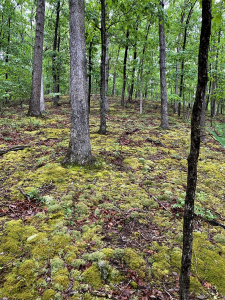
Lichens and mosses flourished in cushiony mounds.
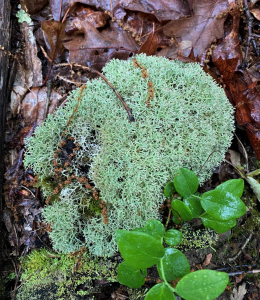
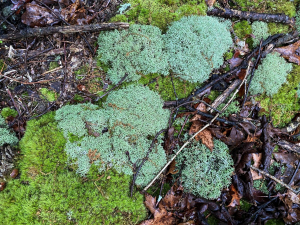
Lowbush blueberry and rattlesnake weed likewise are quite content on these excessively well-drained, inherently low fertility upper west- and south-facing slopes.
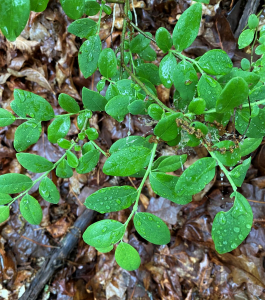
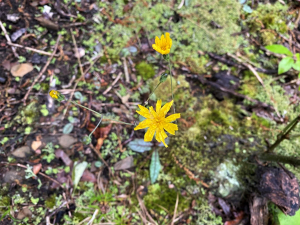
Yet, even these relatively poor sites evidence the continuing cycle of life and death. The wood ear mushrooms (below left) are the fruiting bodies of the fungi consuming the dead branch lying on the forest floor. I have since found enough wood ear mushrooms here in Alabama to attest to their culinary attributes. Wood peckers are foraging for beetle larvae on the downed Virginia pine stem below right.
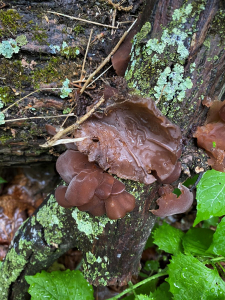
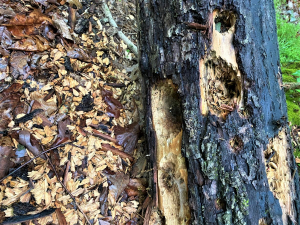
Among the prior autumn’s leaf litter, the flowers of an oak root parasite (AKA cancer root, bear corn, squaw root) are sprouting.
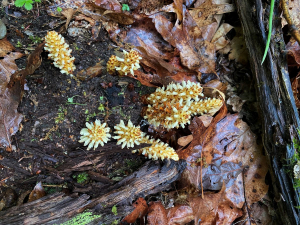
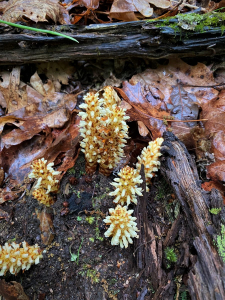
As I said earlier in the Post, as a youngster I would walk along and fish from the shear far-side of the ponds. I stayed on the Evitts Creek side on this visit for two reasons. I believe that the brush and tree growth is more of a thicket than it was then. Secondly, I am far less sure-footed and nimble now! I am not in the mood to tumble into the drink!
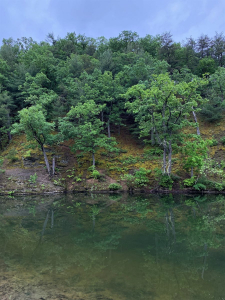
I owe much of my thirst for Nature-knowledge to Doc Workman, who remains my hero and career-long mentor. We have stayed close over the fifty-plus years since that systematic botany course. A few years ago Judy and I helped endow a named Allegany College of Maryland forestry scholarship in his honor. I urge readers to consider contributing to the endowed fund.
Charitable donations can be made to the Dr. Glenn O. Workman, Jr. Scholarship with checks made payable to the Allegany College of Maryland Foundation and mailed to the following address:
Allegany College of Maryland Foundation, Inc.
12401 Willowbrook Road, SE
Cumberland, MD 21502
I have occasionally used this axiom over my career: People don’t care how much you know until they know how much you care. Doc cared…and that made all the difference in the world…for me and for those I’ve touched over my own career! Help me carry Doc’s legacy forward through the annual scholarship.
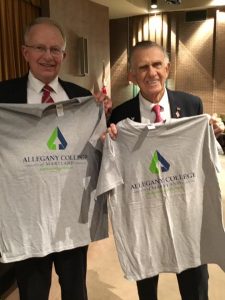
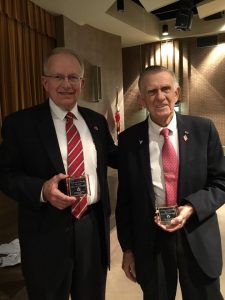
I view Doc through both the lens of an 18-year-old forestry freshman and the eyes of a former president of four universities. Life has been kind to me by placing me with mentors who mattered…and who cared.
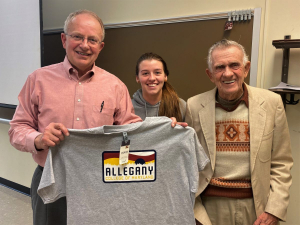
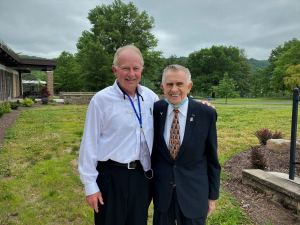
See my November 2017 Post paying tribute to Doc: https://stevejonesgbh.com/2017/11/28/sowing-seeds-tomorrow/
Again, Please consider furthering Doc’s legacy. I now see a man in his low 90s, yet, I will always remember and salute the 40-year-old dynamo who provided wind beneath my wings.
Thoughts and Reflections
I offer these observations:
- We all are time travelers; I’ve covered six and one-half decades since my first visit to this place of deep Nature-memories.
- I relish stirring fond ancient recollections in places of long ago familiarity.
- Perhaps my words and photos will inspire others to visit and reflect upon such places.
Inhale and absorb Nature’s elixir. May Nature Inspire, Inform, and Reward you!
Note: All blog post images created & photographed by Stephen B. Jones unless otherwise noted. Please circulate images with photo credit: “©2021 Steve Jones, Great Blue Heron LLC. All Rights Reserved.”
Another Note: If you came to this post via a Facebook posting or by an another route, please sign up now (no cost… no obligation) to receive my Blog Post email alerts: http://eepurl.com/cKLJdL
And a Third: I am available for Nature-Inspired Speaking, Writing, and Consulting — contact me at steve.jones.0524@gmail.com
Reminder of my Personal and Professional Purpose, Passion, and Cause
If only more of us viewed our precious environment through the filters I employ. If only my mission and vision could be multiplied untold orders of magnitude:
Mission: Employ writing and speaking to educate, inspire, and enable readers and listeners to understand, appreciate, and enjoy Nature… and accept and practice Earth Stewardship.
Vision:
- People of all ages will pay greater attention to and engage more regularly with Nature… and will accept and practice informed and responsible Earth Stewardship.
- They will see their relationship to our natural world with new eyes… and will understand more clearly their Earth home.
Tagline/Motto: Steve (Great Blue Heron) encourages and seeks a better tomorrow through Nature-Inspired Living!
Steve’s Three Books
I wrote my books Nature Based Leadership (2016), Nature-Inspired Learning and Leading (2017), and Weaned Seals and Snowy Summits: Stories of Passion for Place and Everyday Nature (2019; co-authored with Dr. Jennifer Wilhoit) to encourage all citizens to recognize and appreciate that every lesson for living, learning, serving, and leading is either written indelibly in or is powerfully inspired by Nature.
I began writing books and Posts for several reasons:
- I love hiking and exploring in Nature
- I see images I want to (and do) capture with my trusty iPhone camera
- I enjoy explaining those images — an educator at heart
- I don’t play golf!
- I actually do love writing — it’s the hobby I never needed when my career consumed me
- Judy suggested my writing is in large measure my legacy to our two kids, our five grand kids, and all the unborn generations beyond
- And finally, perhaps my books and Blogs could reach beyond family and touch a few other lives… sow some seeds for the future


All three of my books (Nature Based Leadership; Nature-Inspired Learning and Leading; Weaned Seals and Snowy Summits) present compilations of personal experiences expressing my (and co-author Dr. Wilhoit for Weaned Seals and Snowy Summits) deep passion for Nature. All three books offer observations and reflections on my relationship to the natural world… and the broader implications for society. Order any and all from your local indie bookstore, or find them on IndieBound or other online sources such as Amazon and LifeRich.

